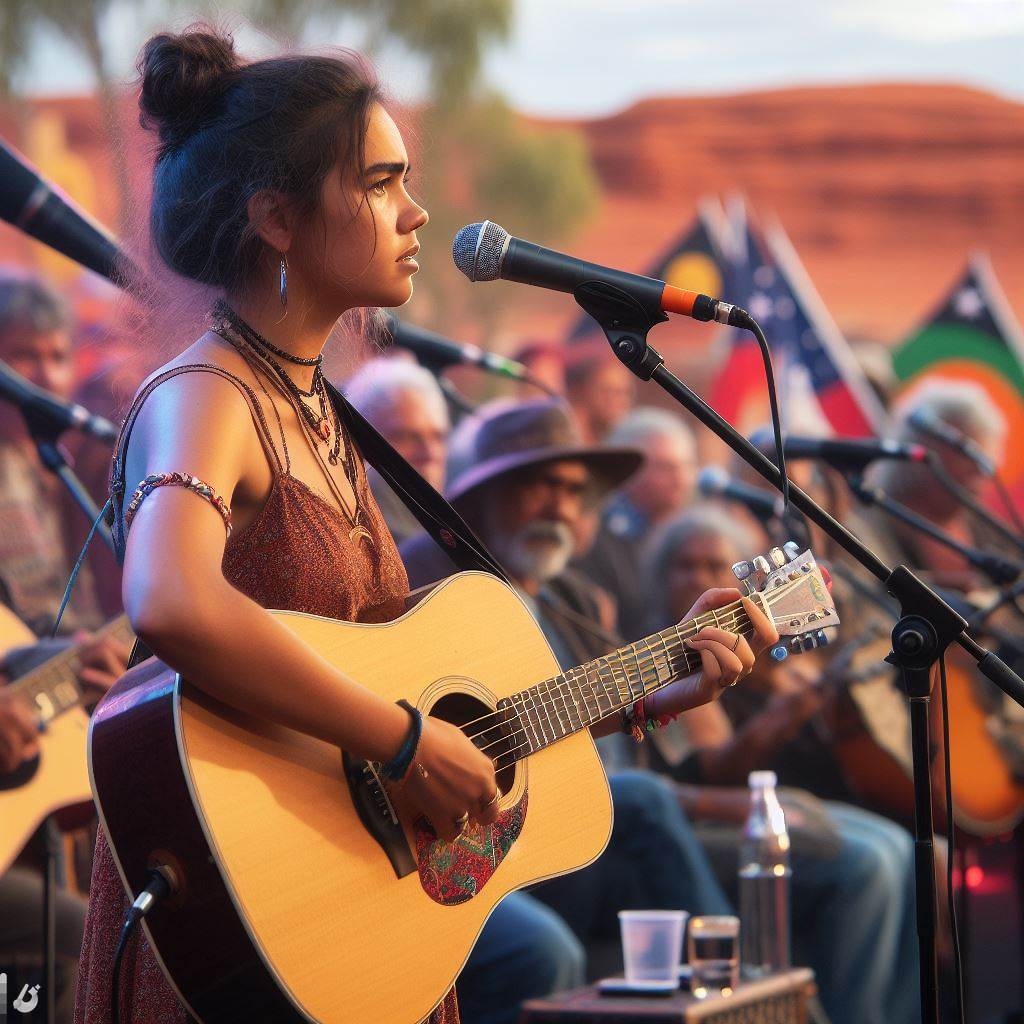Introduction
Music has played a vital role in Australian culture, with its genres evolving significantly over time. From traditional Aboriginal music to contemporary genres, Australian music genres evolution reflects the nation’s multicultural identity.
This blog post explores the evolution of Australian music genres, highlighting their importance in shaping the country’s diverse musical landscape.
Importance of music in Australian culture
The evolution of Australian music genres is a testament to the nation’s multicultural heritage, showcasing the fusion of different cultural influences and the constant innovation within the music industry.
Overview of traditional Australian music
The music of Australia has evolved over time, drawing influences from Indigenous music, traditional instruments, and folk music. These elements have shaped the rich and diverse Australian music genres we know today.
Indigenous music has had a profound impact on Australian music genres. The Aboriginal and Torres Strait Islander peoples have a rich musical heritage that dates back thousands of years.
Their music reflects their deep connection to the land, spirituality, and cultural identity.
Traditional instruments and styles
Traditional instruments such as the didgeridoo, clap sticks, and boomerang have played a significant role in Australian music. The didgeridoo, a wind instrument made from a hollow tree trunk, is one of the oldest musical instruments in the world.
Its unique sound is instantly recognizable and has been incorporated into various genres of Australian music.
Different styles of music have also emerged from different regions of Australia, reflecting the diverse cultural backgrounds of its people.
For example, the music of the Cape York Peninsula combines elements of Aboriginal and Torres Strait Islander styles with contemporary influences, creating a unique fusion.
The significance of folk music in the early days of Australian music
Folk music has been a significant part of Australian music since the early days. It was brought to Australia by settlers from Europe and played an important role in shaping Australia’s cultural identity.
Traditional folk songs told stories of convict life, bushrangers, and the struggles of early settlers.
In the early 20th century, folk music experienced a resurgence in popularity, thanks to the work of collectors and folklorists who sought to preserve traditional Australian songs.
This revival helped to establish folk music as an important genre in Australia and paved the way for future musicians to draw inspiration from these traditional roots.
The significance of folk music in the early days of Australian music cannot be overstated. It provided a means for people to connect with their heritage, share stories, and form a sense of community.
Folk festivals became a gathering place for musicians and enthusiasts alike, showcasing the diverse range of musical talent in Australia.
“The Diverse Evolution of Australian Music: From Rock ‘n’ Roll Roots to Global Sensations”
As Australian music evolved, various genres emerged, influenced by both traditional elements and international trends. Rock ‘n’ roll found its way to Australia in the 1950s, inspiring a generation of musicians and leading to the birth of Australian rock.
Bands like AC/DC and INXS became international sensations, putting Australian music on the global stage.
Other genres such as country, pop, hip-hop, and electronic music have also thrived in Australia, each contributing to the cultural tapestry of the nation.
Australian artists continue to push boundaries and experiment with new sounds, ensuring that the evolution of Australian music genres never ceases.
In essence, the evolution of Australian music genres has been shaped by the influence of Indigenous music, traditional instruments, and folk music.
These elements have played a crucial role in defining the unique and diverse musical landscape of Australia.
From the haunting sound of the didgeridoo to the infectious beats of contemporary pop, Australian music continues to captivate audiences worldwide.
Impact of British colonization on Australian music
The impact of British colonization on Australian music was profound, reshaping the musical landscape of the continent.
First and foremost, British colonization introduced new musical styles and instruments to Australia. With the arrival of the British settlers, traditional indigenous music began to evolve, influenced by European melodies and harmonies.
- The influx of classical and orchestral music brought by the British had a significant impact on Australian music. This genre was embraced and adapted by local composers and musicians, leading to the emergence of a unique Australian classical music scene.
- Classical music became a symbol of refinement and sophistication, reflecting the aspirations of the emerging Australian middle class.
- Orchestral music paved the way for the establishment of symphony orchestras in major Australian cities, fostering an appreciation for classical compositions and attracting internationally renowned conductors and soloists.
- Classical music also influenced the development of choral societies, which became important institutions for promoting vocal music and connecting communities through singing.
In addition to classical music, the emergence of brass bands and marching bands was another direct result of British colonization.
- Brass instruments, introduced by the British, found their place in Australian music and became popular in various contexts such as military parades, public celebrations, and community events
- Brass bands and marching bands played a significant role in building a sense of national identity, as they symbolized patriotism and civic pride.
- These bands were not only entertaining but also provided a forum for aspiring musicians to hone their skills and share their talents with audiences.
The influence of British colonization on Australian music extended beyond the introduction of new styles and instruments. It also brought along social changes that shaped the music industry.
- The establishment of music schools and conservatoires modeled after British institutions enhanced the formal training and education of Australian musicians, nurturing local talent.
- British influences also inspired the growth of music publishing, recording, and broadcasting industries in Australia, providing platforms for the dissemination of music.
- The presence of British musicians and conductors in Australia facilitated cultural exchange and collaboration, enriching the local music scene.
- New opportunities for Australian composers and performers arose as they gained exposure to a wider audience and received recognition overseas.
In a nutshell, the impact of British colonization on Australian music was profound and enduring.
It introduced new musical styles and instruments, stimulated the growth of classical and orchestral music, witnessed the emergence of brass bands and marching bands, and brought along social changes that shaped the music industry.
Australian music owes a great deal to its British roots, while also maintaining its unique identity influenced by Indigenous traditions and multiculturalism.
Your Personalized Career Strategy
Unlock your potential with tailored career consulting. Get clear, actionable steps designed for your success. Start now!
Get StartedRead: Music Production: A Guide for Aussies
Rise of popular music in Australia
American music: The impact of American music on Australian music trends cannot be underestimated.
The Australian music scene has been greatly influenced by American music throughout its evolution. The introduction of American music to Australia in the early 20th century brought about a significant change in popular music trends.
American artists like Elvis Presley and Bill Haley had a profound impact on Australian musicians and the audience.
Development of rock and roll: Rock and roll had a significant influence on the Australian music scene, shaping its evolution.
Rock and roll, which originated in the United States, made its way to Australia in the 1950s. This genre brought with it a rebellious and energetic spirit that resonated with the youth.
Australian musicians quickly embraced rock and roll, adapting it to their own style and creating a distinct sound that reflected the cultural context of the country.
Australian artists: Australian artists made a noteworthy contribution to the popular music scene, creating a unique sound.
The 1960s marked a turning point for popular music in Australia. The British Invasion, led by bands like The Beatles and The Rolling Stones, had a profound influence on Australian musicians.
This period saw the rise of local acts such as The Easybeats and The Bee Gees, who emulated the British sound but also infused it with their unique Australian flavor.
In the 1970s, Australian artists began to assert their identity and contribute significantly to the popular music scene. Bands like AC/DC and Cold Chisel became iconic, not just in Australia but also internationally.
They brought a raw and energetic style to rock music, which resonated with audiences worldwide.
“Decades of Diversity: Evolution and Innovation in Australian Music
The 1980s witnessed a diversification of music genres in Australia. The emergence of pub rock, new wave, and synth-pop bands allowed for greater experimentation and creativity.
Australian acts such as INXS, Midnight Oil, and Kylie Minogue gained popularity both locally and abroad, showcasing the diversity and talent of the Australian music scene.
The 1990s saw the rise of alternative and indie music in Australia. Bands like Silverchair, Powderfinger, and The Whitlams captured the attention of a new generation of music lovers.
This period also witnessed the success of female artists such as Natalie Imbruglia and Missy Higgins, further diversifying the representation of Australian music.
Thriving Diversity: The Evolution and Global Impact of Australian Music
In recent years, Australian music has continued to thrive with the emergence of new genres and acts. Hip-hop and electronic music have gained significant popularity, with artists like Hilltop Hoods and Flume making waves both in Australia and globally.
This fusion of different musical styles reflects the multicultural makeup of Australian society.
The evolution of Australian music genres has been shaped by various influences, with American music playing a pivotal role in its development.
Additionally, Australian artists have contributed greatly to the popular music scene, putting their unique spin on different genres and creating a sound that is distinctly Australian.
The future looks promising for the Australian music industry, as it continues to evolve and produce talented artists across a wide range of genres.
Read: How to Network in Australia’s Music Scene
Golden era of Australian pub rock
During the 1970s and 1980s, pub rock became a prominent music genre in Australia. It rose to popularity and left a lasting impact on the Australian music scene. Here are some notable Australian pub rock bands and their cultural significance:
Cold Chisel
Formed in 1973, Cold Chisel quickly rose to fame with their energetic live performances and relatable lyrics. Their songs like “Khe Sanh” and “Flame Trees” became anthems for working-class Australians.
AC/DC
This iconic band needs no introduction. With their hard-hitting rock sound and electrifying performances, AC/DC became one of the most successful Australian bands of all time. They paved the way for future rock acts in the country.
Australian Crawl
Known for their catchy tunes and unique sound, Australian Crawl brought a refreshing experience to pub rock. Their hits like “Reckless” and “Boys Light Up” captured the essence of Australian coastal culture.
Stand Out with a Resume That Gets Results
Your career is worth more than a generic template. Let us craft a resume and cover letter that showcase your unique strengths and help you secure that dream job.
Get HiredThe Angels
With their raw, no-nonsense rock sound, The Angels gained a strong following. Their album “Face to Face” remains a classic in Australian rock history, representing the rebellious spirit of the era.
Midnight Oil
This politically charged band used their music as a platform for activism. Their passionate performances and thought-provoking lyrics made them one of Australia’s most respected rock bands.
Rose Tattoo
Known for their tough image and high-energy shows, Rose Tattoo brought a powerful mix of hard rock and blues to the pub rock scene. Their self-titled debut album is considered a pub rock masterpiece.
Jimmy Barnes
Although a solo artist, Jimmy Barnes was a significant figure in the pub rock era. His powerful voice and charismatic stage presence made him a beloved Australian rock icon.
Pub rock had a profound cultural significance in Australia. It was a reflection of the working-class ethos and served as a vehicle for expressing the frustrations and aspirations of the everyday Australian.
The pub rock scene fostered a sense of community, with live music becoming a staple in pubs across the country.
This golden era of Australian music also played a crucial role in shaping the identity and sound of future Australian genres.
Many bands that emerged from the pub rock scene went on to achieve international success, helping to put Australian music on the global map.
The impact of pub rock can still be felt to this day. Its influence can be heard in modern Australian rock, and its legacy is celebrated through tribute bands and reunion gigs.
Pub rock remains a cherished part of Australian music history, representing a time when live music was at the heart of the nation’s entertainment.
Basically, the rise of pub rock in the 1970s and 1980s marked a golden era in Australian music. Bands like Cold Chisel, AC/DC, and Australian Crawl dominated the scene, leaving an indelible impact on the cultural landscape.
Pub rock served as a platform for self-expression and community, shaping the sound of future Australian genres. Its legacy continues to be celebrated, ensuring that the spirit of pub rock lives on.
Read: Australian Music Awards: A Closer Look

See Related Content: Top Australian Acting Schools: A Comprehensive Guide
Gain More Insights: Legal Pitfalls for Artists in AU: Stay Informed!
Emergence of Unique Australian Music Genres
When it comes to music, Australia has a rich and diverse history of unique genres that have emerged over the years. From Australian hip-hop to country, these genres showcase the country’s cultural and musical diversity.
In this section, we will delve into the development of these genres, the fusion of musical styles, Indigenous influences, and the successful Australian musicians who have contributed to these genres.
The fusion of musical styles and Indigenous influences in contemporary Australian music
The development of unique Australian music genres has been a fascinating journey. Australian hip-hop, for example, emerged in the early 1990s as a response to the dominant American hip-hop scene.
Artists like Bliss n Eso, Hilltop Hoods, and 360 made a significant impact on the genre, incorporating Australian slang and themes into their music.
Country music has also flourished in Australia, with its own distinct sound and style. Influenced by American country music, Australian country artists like Lee Kernaghan, Slim Dusty, and Kasey Chambers have created a unique blend of country with Australian storytelling and themes.
Their music resonates with the Australian audience, capturing the essence of rural life and the country’s landscapes.
Transform Your LinkedIn for Maximum Impact
Elevate your professional brand with a LinkedIn profile that attracts recruiters, showcases your expertise, and maximizes opportunities. Stand out in your industry with a profile built for success.
Boost ProfileContemporary Australian music has also seen the fusion of musical styles and Indigenous influences.
Artists like Geoffrey Gurrumul Yunupingu and Jessica Mauboy blend Indigenous music traditions with pop and R&B, creating a distinct sound that celebrates Australia’s Indigenous culture.
Their music not only entertains but also educates and promotes understanding of Indigenous culture to a broader audience.
Successful Australian musicians who have contributed to these genres
Australian musicians who have contributed to these genres deserve recognition for their impact on the music industry. One such artist is Sia, known for her captivating vocals and songwriting skills.
She has collaborated with various artists worldwide and has achieved commercial success with her unique musical style that transcends genres.
Another notable artist is Keith Urban, who has made a significant mark in both the Australian and international country music scenes.
With his impressive guitar skills and heartfelt lyrics, Urban has become a global ambassador for Australian country music.
Troye Sivan is another rising star who has garnered international recognition with his pop music infused with personal storytelling. His music explores themes of identity, sexuality, and self-discovery, resonating with a diverse audience.
The emergence of unique Australian music genres continues to shape the country’s cultural identity. These genres not only provide a platform for musicians to express themselves but also reflect Australia’s multicultural society.
Essentially, the development of unique Australian music genres, such as Australian hip-hop and country, highlights the country’s cultural and musical diversity.
The fusion of musical styles and Indigenous influences adds depth and richness to contemporary Australian music.
Successful Australian musicians like Sia, Keith Urban, and Troye Sivan have contributed significantly to these genres, leaving a lasting impact on the music industry.
These genres and artists showcase Australia’s rich musical landscape and demonstrate the global influence of Australian music.
Read: Building a Music Career in Australia
Current Australian music scene
In the current Australian music scene, diversity and popularity are thriving.
Australian music today is a fusion of various genres, which appeals to a wide range of listeners.
From indie rock to electronic music, the choices are abundant, catering to different musical tastes.
Australian musicians have gained global recognition and success, making a significant impact on the international stage.
Artists such as Tame Impala, Sia, and Angus & Julia Stone have captured the attention of a worldwide audience. Their unique sound and talent have helped put Australian music on the map.
The success of Australian artists globally
Thanks to digital platforms and streaming services, the Australian music industry has been transformed. These platforms have provided artists with new avenues to showcase their music and connect with fans.
Streaming services like Spotify have made it easier for musicians to reach a global audience. They allow fans to discover new Australian artists and support their favorite musicians by streaming their music.
Digital platforms have also changed the way music is consumed, shifting from physical copies to digital formats.
This has encouraged the growth of independent and emerging artists, as they no longer rely solely on major record labels for distribution.
The impact of digital platforms and streaming services on the Australian music industry
Moreover, digital platforms have made it easier for artists to collaborate and experiment with different styles and genres.
Artists can now work with producers and musicians from around the world, breaking down geographical barriers.
The impact of digital platforms and streaming services has not only been felt by musicians but also by the music industry as a whole.
Record labels and music promoters now rely heavily on digital marketing and promotion strategies to reach their target audience.
Social media platforms like Instagram and TikTok have become essential tools for promoting new music releases.
In addition, the prevalence of streaming has changed the revenue structure of the industry.
Artists now earn through streaming royalties, and live performances have become a significant income source.
The growing popularity of music festivals in Australia, such as Splendour in the Grass and Laneway Festival, is a testament to the thriving music scene.
These festivals attract both local and international artists, showcasing the diversity and talent in Australian music.
Furthermore, the government has played a role in supporting and promoting Australian music.
Initiatives like the Australia Council for the Arts and the Australia Music Industry Network provide funding and resources for musicians.
They also advocate for the fair treatment of artists and help create opportunities for them to thrive.
In general, the current Australian music scene is vibrant and diverse, appealing to a wide audience.
Australian artists have achieved global success, thanks to their unique sound and talent. Digital platforms and streaming services have transformed the music industry, providing new opportunities for musicians.
The impact has been felt by artists, record labels, and music promoters alike. With government support and initiatives, the Australian music scene is set to continue evolving and making waves both locally and internationally.
Delve into the Subject: Education Paths for Aspiring Aussie Directors
Conclusion
In closing, the evolution of Australian music genres has been a rich and diverse journey. From its roots in Indigenous and folk traditions, Australian music has embraced a wide range of influences, including rock, pop, hip-hop, and electronic genres.
Throughout this evolution, Australian music has played a crucial role in shaping the cultural identity of the nation.
It has provided a platform for artists to express their experiences and perspectives, reflecting the unique Australian landscape and narrative.
Australian music has also fostered a sense of national pride, connecting people from different backgrounds and generations. It has become a powerful tool for storytelling, connecting communities, and celebrating diversity.
As we reflect on the evolution of Australian music genres, it is clear that they are a testament to the creativity and resilience of Australian artists.
They have defied geographic barriers and gained global recognition, making a significant impact on the international music scene.
In light of this, we invite you to explore the vast world of Australian music. Challenge yourself to go beyond the mainstream and discover the hidden gems that define the essence of Australian sound.
Through this exploration, you will not only expand your musical horizons but also gain a deeper understanding of Australia’s rich cultural tapestry.
So, let us embark on a journey of musical discovery, where every note carries the spirit of Australia. Together, we can celebrate the evolution of Australian music and appreciate its enduring significance in shaping our cultural landscape.




